An investigation of the growth and protection of local coral reef in Shenzhen, China, and public perception.
The unaddressed threat to Coral Reefs
In the shallow ocean floors of Shenzhen Da Peng Bay, lay the starving corals slowly reaching their demise. When asked to recount his diving experiences, Jay anxiously shakes his head, “These corals are helpless victims from mankind’s abuse.” Seeing the fragile white bones of the corals, he claims: “The unaddressed culprit behind this tragedy is fast fashion and it has to end.”
The delicate reefs are the rainforest of the ocean. Not only do the coral polyps surround themselves with the tentacles that capture food, but they also add a complex array of colours to the sea, surrounding themselves with tentacles that capture food. However, despite the important roles coral reefs serve as providing shelters for marine animals and protecting coastlines from erosion, human activities continue to threaten their existence.
According to investigations from John Hopkins University, in Indonesia, where one-third of the world’s corals are located, only around 30 per cent of coral reefs are kept well.
“Through my diving experiences, I’ve witnessed the desolated marine environment when corals are damaged,” said Jay-Wok Lim, aged 54, the founder of a Shenzhen Coral Reef Conservation Group Divee4Love solemnly, “but currently, not enough effort is established to counter chemical runoffs and toxic materials polluting the ocean by the textile industry.”
Here, near Shenzhen Bay, lay tons of garbage and abandoned fishing nets that are buried with the bodies of countless reefs, revealing a scene that is common in multiple coastlines around the world. This represents countless human abuses that will lead to the death of nearly all the reefs in thirty years.
Progressing to the 21st century, coral reefs are no longer simply victims in the wake of the historic coral-bleaching event. Between economic profits from corporations and demand for popular culture, coral reefs are near the brink of destruction at something we neglect: toxic fashion.
Existing efforts to solve the issue
Our team R.A.T.I.O, founded in 2018, investigated ways to mitigate the human threat to marine ecosystems, especially focusing on the preservation of coral reefs. R.A.T.I.O further interviewed and researched environmentalists and fashion experts to note the correlation between the two.
In reports shown by Earth Projects, the death of corals is promoted through the increased use of cyanide in fishing due to the escalating demand for ornamental fish, the employment of explosives to bomb fishes killing both corals and small creatures living in coral reefs and industrial pollution such as copper which negatively affects the growth of corals; polluted water also spreads diseases among corals.
As problems of warming waters, ocean acidification, and pollution are contributing to the destruction of coral reefs, there are certain actions in the status quo to prevent further losses of reefs. Efforts include establishing marine protected areas, regulating destructive fishing practices, and reducing wastes from agricultural practices.
Attempting to solve the issue, R.A.T.I.O partnered with local environmental charity organisation Dive4Love working to conserve the works of the ocean. Through a year-long collaboration, R.A.T.I.O participates to advocate for the practices of restoring coral reef ecology, help build an educational system on ocean awareness through spreading methods of ocean conservation and stimulate the cross-border participation of the public, enterprises, government. R.A.T.I.O further documented the procedure for how reefs are restored through a week-long diving experience that showed attempts to plant reefs.
The three main parts of the project are: underwater operation maintenance, fishing village tourism, and coral reef protection zone construction that aims to establish a 100-meter-long coral tourism belt. This innovative solution addresses the concerns of multiple stakeholders--helps establish a coral protection system for divers to cope with the transformation of the fishing industry and to direct the income of fishermen to coral tourism that sets a precedent for the construction of coral reef maintenance areas.
“Our job as divers help cultivate coral seedlings on land and wait for it to develop and then transplant it to the coral garden on the seafloor,” said Liu Si Qi, aged 35, the chief diving trainer from Shenzhen China who planted 5606 corals and rescued 68 coral stumps, “then we break off stumps from coral reefs that are already on the verge of death and then transplant them to submarine coral gardens. However, unknown difficulties still face us with regards to the unregulated textile industry.”
What’s wrong with fast fashion?
This relates to a problem, although efforts of major environmental corporations around the world are especially focused on combatting climate change, and rising sea temperatures. Few corporations proposed solutions towards the textile industry-the second largest contributor of water pollution according to UNEP.
According to data from World Wildlife Fund, one of the most widely used textiles-cotton accounts for 18 per cent of pesticides worldwide and is toxic to marine species. Polyester (nondegradable) is one of the leading causes of microfibre in ocean. Similarly, a study shown by ecologist Mark Brown reveals that microfibres are finding their way into the oceans, where fashion materials such as polyester are non-biodegradable and accumulate to fishes when planktons consume it.
China is a country where 60 per cent of water sources are considered unfit for human contact. 10 per cent of all industrial wastewater emissions come directly from the fashion industry with 72 per cent of the toxic chemicals in the water coming from textile dyeing, according to The Guardian.
“You can tell what colour will be in fashion next season based on the colour of the rivers,” said Mei Liu, aged 59 from PingShan Shenzhen.
It is impossible to hide the impact of the rampant fast fashion industry on China, and regular consumers are waking up to the fact that the status quo needs to change.
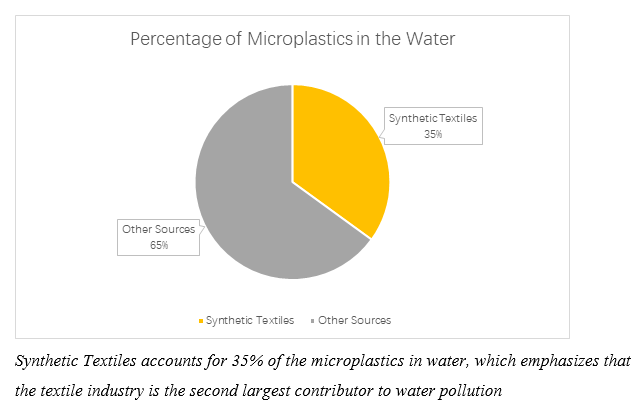
Synthetic Textiles accounts for 35% of the microplastics in water, which emphasizes that the textile industry is the second largest contributor to water pollution
“Fashion needs to be beautiful, safe, and fair for everyone,”
Thus, a new approach, one that combines popular culture with environmental protection is a proposed alternative.
Progressing towards the 21st century, environmental awareness of sustainable fashion has risen. By attending multiple fashion conferences hosted in Shenzhen Sea World, R.A.T.I.O witnessed the attempts by public artists to spread awareness on coral protection through graphic and direct messages.
“Fashion needs to be beautiful, safe, and fair for everyone,” claims Marco Liang, the co-organiser for the fashion exhibit, “people need to make a fashion statement that matters, and brands will listen and act.”
Multiple artists from the exhibit claim that their innovation was derived from the beauty of corals and the want to preserve the delicacy. Fashion brands such as Alexander McQueen, Calvin Klein, Burberry, Stella McCartney are beginning to make dresses from recycled materials. Companies such as Colorifix for instance uses synthetic biology to produce less water pollution.
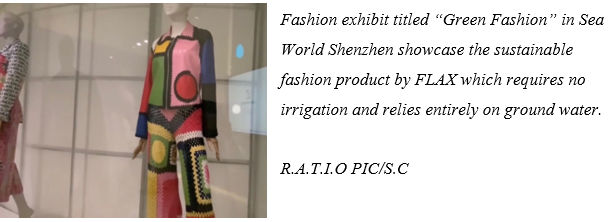 However, only a few of the fashion brands are becoming sustainable, and fast fashion continues to be the trend. Additionally, by surveying a sample of Shenzhen consumers, only 22 per cent of the people claim that they will be willing to pay a premium for sustainable fashion, and only 53 per cent of respondents considered the dangers of packaging and cared about pollution-free production process.
However, only a few of the fashion brands are becoming sustainable, and fast fashion continues to be the trend. Additionally, by surveying a sample of Shenzhen consumers, only 22 per cent of the people claim that they will be willing to pay a premium for sustainable fashion, and only 53 per cent of respondents considered the dangers of packaging and cared about pollution-free production process.
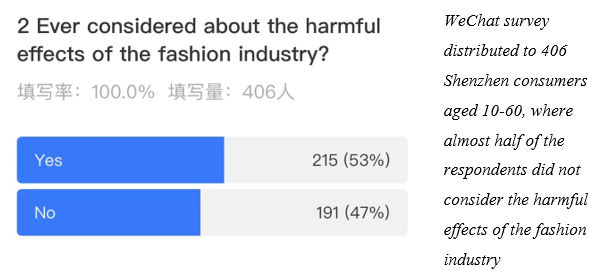
Educating and stimulating participation of the public
To address the skepticism and indifference of young consumers for fashion products, R.A.T.I.O proposed education of ocean awareness to spread the concept and methods of ocean conservation. In attempts to stimulate the cross-border participation of the public, R.A.T.I.O initiated several events in school. In June, a “Crazy Me Coral Day” was created that seeks to boost awareness of coral reefs' destruction through games, t-shirt dying and posters.
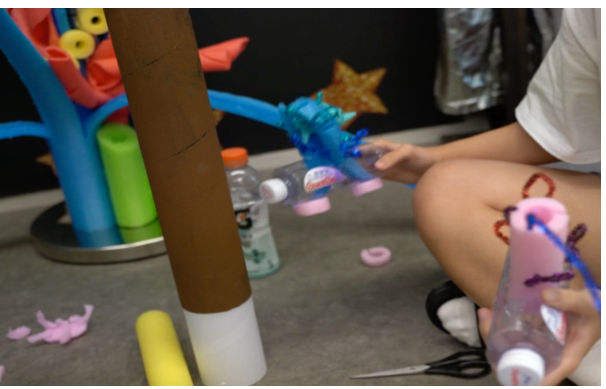
Constructing coral reefs out of recycled materials during preparations for Crazy Coral Day at BASIS school in Huizhou Park Lane Harbor
R.A.T.I.O PIC/M. G
“The coral games were entertaining and educational,” says Jody Belcon, environmental science teacher and supervisor of the event, “the flippers and diving snorkels enable children to have a diving experience and watering the bowl that contains a dried coral invokes the civic responsibility within the children to save corals.
Other teachers also approved of the educational purposes of the game. Almost all the participants claimed that it was shocking to see the status of reefs, and how it was impacted by human activities. They pointed out that the “cleaning the pollutant” game not only simulates ocean pollution but also enables children to pick out the garbage that entangles the reefs.
Connecting the detrimental effects of fashion to corals, “Powder dye” activity was created. T-shirts made of organic fibre were not only dyed in the multitude of colours that resembled the under-ocean beauty of coral reefs but also promotes sustainable fashion.
“It is a new and innovative approach,” Dr. Lotus, a biologist and marine scientist said in the interview, “corals are the rainforest of the ocean, so if we lose the coral, it is equivalent to losing the rainforest. It is not the coral which dies, but all the other species around it. Thus, slow fashion helps address the problem.”
New Alternatives to Raise Awareness
Fast fashion and the loss of coral reefs are closely related. According to Science Direct, organic cotton, one of the most natural fabrics, grown without machine harvesting is shown to use 62 per cent less energy and 88 per cent less water than conventional cotton. Recycled polyester and nylon are produced from a variety of waste materials such as PET plastic bottles, apparel, or nylon fishing nets, wastes that are common to be found killing ocean creatures. Thus, the recycling of polyester consumes less energy during the production process, resulting in a considerable reduction in carbon emissions. Recycled silk can help reduce any excess material created during the steps of the product emissions. Recycled silk can help reduce any excess material created during the steps of product manufacturing and therefore reduce waste disposal and emission.
Ending the injustice to coral reefs by making more ethical fashion choices
It has been years since fast fashion’s detrimental effects reach us in unimaginable ways. Although individuals are prone to escalate themselves from the destruction of coral reefs, saving corals help restore biodiversity, restore food security, boost income, serve as natural marine barriers for protection, and contribute to medicine.
Jay Wok Lim has faced immense difficulties trying to restore coral reefs through Dive4Love. However, he remains optimistic about the future of coral reefs after witnessing R.A.T.I.O’s efforts to create new innovative solutions, representing a new generation’s urge to conserve marine ecosystems.
“Mystery and the power of nature is a compelling source for artists.”
Promoting sustainable fashion may just be the only solution to saving endangered corals and to creating a greener future.
Credits: Raising Awareness to Inspire Other (R.A.T.I.O), BASIS International School Parklane Harbor, Arthur Huang, Ivy Zhang, Michael Gao, Noah He and Serena Chiang, Broadwater Academy, Caroline Zeng.



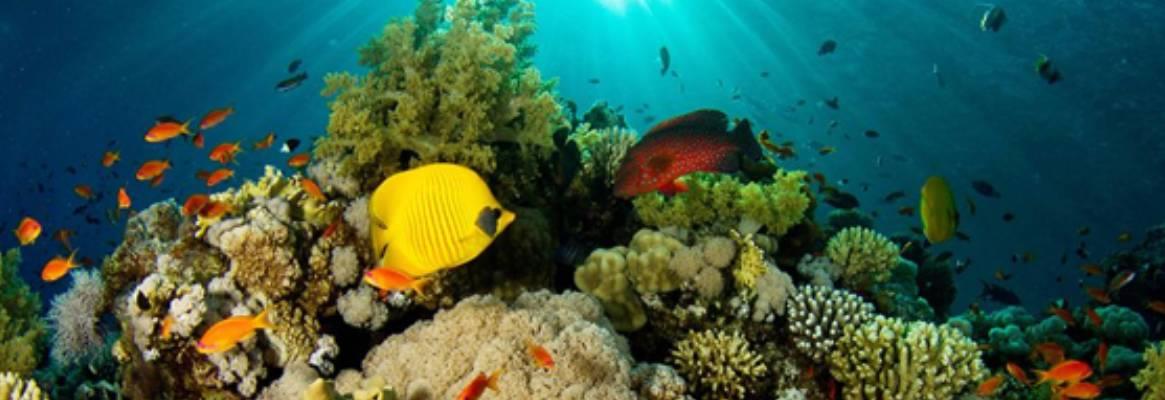




Comments